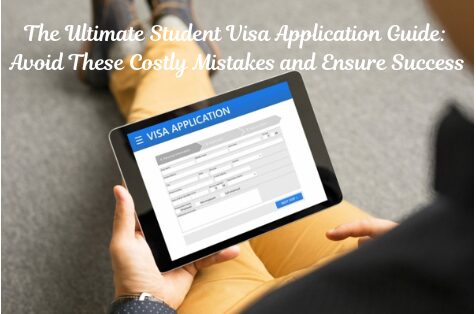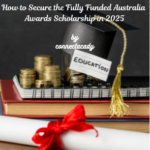Are you looking to study abroad but unsure about how to navigate the student visa application process? This ultimate student visa application guide will help you understand the steps involved, common mistakes to avoid, and how to ensure your application is successful. By the end of this post, you’ll be well-equipped to submit a flawless application and increase your chances of getting your student visa approved.

Why You Need the Ultimate Student Visa Application Guide
A student visa is more than just a formality, it’s your ticket to studying in a foreign country. Without it, your dreams of studying abroad could be delayed or even derailed. But the process of applying for a student visa can be complicated, especially if you’re unaware of the common pitfalls that many applicants face. This guide is here to save you time, money, and stress by walking you through the entire application process and helping you avoid costly mistakes.
Understanding the Student Visa Process
Navigating the student visa application process is crucial for those aspiring to study abroad. In this section of The Ultimate Student Visa Application Guide, we’ll break down the student visa process, explain the different types of visas, and outline the key eligibility criteria for a successful application.
What Is a Student Visa?
A student visa is a type of visa granted to individuals who wish to study in a foreign country. It allows you to reside in that country for the duration of your educational program. Student visas are essential for legal entry into the country and for staying there for the entire period of your studies. Without a student visa, you would not be able to legally attend a university or college, making this step a vital part of your study abroad journey.
Types of Student Visas
Each country has its own student visa system, so it’s important to understand which visa applies to your situation. Here’s an overview of the most common types of student visas:
- US Student Visa: For students wishing to study in the United States, the F-1 visa is the most common, designed for academic studies. There’s also the J-1 visa for exchange programs.
- UK Student Visa: The Tier 4 (General) student visa is required for students planning to study in the UK.
- Canada Study Permit: Canada issues study permits for international students enrolled in full-time programs lasting more than six months.
- Australian Student Visa: The subclass 500 visa is the standard student visa for Australia.
Each country’s visa requirements differ, so make sure to carefully research the visa process for your chosen destination.
Key Eligibility Criteria
To successfully apply for a student visa, you need to meet several key eligibility criteria:
- Educational Requirements: You must be accepted into a recognized educational institution. This is usually confirmed with an acceptance letter or offer letter from your school.
- Financial Proof: You need to show evidence that you can afford tuition fees, living expenses, and other costs. Countries like the US, UK, and Canada require proof of sufficient funds, which can include bank statements, sponsorship letters, or scholarship awards.
- Health and Insurance: Some countries require international students to have health insurance or undergo medical checks before they can obtain a visa.
- Language Proficiency: You may need to demonstrate your proficiency in the language of instruction (typically English) by taking tests like IELTS or TOEFL.
By meeting these basic requirements, you’ll be on your way to securing a student visa and successfully beginning your international academic journey.
Common Mistakes to Avoid During the Student Visa Application
Navigating the student visa application process can be a complex journey, and even small mistakes can lead to major delays or rejections. In this section of the Student Visa Application Guide, we’ll highlight common pitfalls and provide tips on how to avoid them, ensuring a smooth application process.
Failing to Submit Accurate Information
Accuracy is crucial when completing your student visa application. Even a minor error, such as a misspelled name or incorrect date of birth, can cause delays or a rejection of your application. Be diligent when filling out your forms, and double-check all the information before submitting it. The consequences of submitting incorrect details can range from delays to outright denial of your visa application, which could significantly affect your study plans.
Missing Important Deadlines
Missing a visa application deadline can seriously impact your chances of securing a student visa. Different countries have varying deadlines for visa applications, and these can sometimes be months in advance of your program’s start date. To avoid unnecessary stress:
- start your application process early,
- keep a checklist of deadlines, and
- make sure all your materials are submitted well in advance.

Timeliness is key to ensuring that you have enough time for any additional steps, like interviews or document requests.
Not Providing Enough Financial Evidence
Financial proof is a major requirement for most student visa applications. This typically includes bank statements, proof of funding, or a sponsor’s letter. If you fail to provide sufficient financial evidence, your application could be rejected. Countries like the US, UK, and Canada often require you to demonstrate that you have enough money to cover tuition fees, living expenses, and other costs. If you don’t meet these requirements, it could be difficult to get approval.
Overlooking Required Documents
Every country has its own set of required documents for student visa applications. Missing essential documents like your passport, medical records, or proof of accommodation can cause serious delays. Create a comprehensive list of required documents based on the visa guidelines of your destination country. This will ensure you have everything prepared before you submit your application. Keep in mind that different visa categories may require additional documents such as academic transcripts or language proficiency test results.
Ignoring the Interview Process
Many countries require an in-person or virtual interview as part of the visa application process. Failing to adequately prepare for this interview can result in a missed opportunity. Be sure to practice common interview questions and review your application thoroughly. The goal is to demonstrate to the visa officer that you are a serious student and fully committed to your academic journey. Preparation is key, so dress appropriately, bring all required documents, and be ready to discuss your study plans with confidence.
By following this Student Visa Application Guide, you can avoid these common mistakes and improve your chances of getting your student visa approved quickly and successfully.
Step-by-Step Guide to the Student Visa Application Process
Step 1: Research and Choose the Right Student Visa
The first step in the Student Visa Application Guide is selecting the appropriate visa for your chosen country and course. Each country has different types of student visas, so you’ll need to ensure you apply for the right one. For example:
- US: F-1 visa for academic studies
- UK: Tier 4 (General) student visa
- Canada: Study Permit
- Australia: Subclass 500 visa
Be sure to check the eligibility requirements for the visa you choose, including language proficiency tests, financial stability, and the course you’re enrolling in.
Step 2: Gather Your Documents
Before submitting your application, you’ll need to gather the essential documents. These typically include:
- Proof of Enrollment: An acceptance letter from your educational institution.
- Financial Documents: Bank statements, affidavits of support, or scholarship letters to prove you can cover tuition fees and living costs.
- Passport and Visa Forms: Valid passport and completed visa application form.
- Health Insurance: Proof of health coverage as required by your destination country.

Ensure that all documents are accurate and up-to-date to avoid any delays or rejections.
Step 3: Submit Your Application
You can submit your student visa application either online or via a paper-based process, depending on the country. Online applications are generally faster, with some countries offering streamlined digital processes. Always double-check that all forms are completed correctly and that you’ve included all necessary documentation.
Step 4: Pay the Application Fees
Visa application fees vary by country, but they generally range from $100 to $500. Some countries may also charge additional service fees, so be sure to check ahead. To avoid unexpected costs, research the visa fees thoroughly and ensure you understand all associated expenses.
Step 5: Attend the Visa Interview
Many countries require a student visa interview. Prepare by:
- Reviewing your application: Be ready to answer questions about your course, funding, and future plans.
- Gathering documents: Take all your supporting documents to the interview.
- Staying calm and confident: A positive attitude can make a big difference in your chances of success.
Step 6: Wait for Approval
After your application is submitted, processing times can range from a few weeks to several months. During this period, the visa authorities will review your documents and may request additional information. Be patient, and track your application status regularly.
By following this Student Visa Application Guide, you’ll significantly increase your chances of success. Avoid these common mistakes, and you’ll be on your way to studying abroad in no time!
How to Maximize Your Chances of Success
Navigating the student visa application process can be challenging, but with the right strategies, you can improve your chances of success. In this section of the Student Visa Application Guide, we’ll share key tips to ensure your application stands out and increases your chances of getting approved.
Seek Professional Help
When applying for a student visa, it’s crucial to have everything in order. If you feel uncertain or overwhelmed by the process, consulting an immigration lawyer or visa expert can significantly boost your chances of success. Immigration lawyers are trained to navigate the complexities of visa applications and can help ensure that your application is complete and accurate. These experts are especially valuable when you face unique circumstances, such as complex visa requirements, previous visa denials, or questions about financial documentation. By seeking professional help, you can avoid costly mistakes and streamline your application process.

Stay Organized and Prepared
One of the most important factors in a successful student visa application is staying organized. Keeping track of documents, deadlines, and steps in the process can help prevent delays or missing crucial information. Here are some tips to stay organized:
- Create a Checklist: Make a list of all the documents required for your application and cross them off as you collect them.
- Set Reminders: Use digital calendars or apps to set reminders for important deadlines and appointments, like visa interviews or document submission.
- Keep Copies of Everything: Always keep a copy of all submitted documents and forms for your records. It’s a simple step that can save you time and hassle later.
Use Technology for Help
The right tools can make the application process smoother and more efficient. There are several apps and platforms designed to assist you during your visa application journey:
- Visa Application Trackers: Websites like VisaHQ and Visa Tracker let you track the status of your visa application, reducing stress and uncertainty.
- Document Management Apps: Apps such as CamScanner or Evernote can help you organize and scan important documents, ensuring everything is in order.
- Interview Preparation Tools: Some platforms offer practice visa interview questions to help you prepare for your interview with confidence.
By utilizing technology, you can stay on top of your application process, reducing errors and ensuring all tasks are completed on time.
Conclusion and Final Tips for a Successful Student Visa Application
Securing a student visa is a critical step toward your international education journey. As outlined in this Student Visa Application Guide, avoiding common mistakes and following the correct steps can significantly increase your chances of success. Let’s recap the key points to ensure you’re fully prepared:
- Choose the Right Visa: Ensure that you apply for the correct student visa based on your destination country and course type. Research the requirements thoroughly for countries like the US, UK, or Canada.
- Avoid Mistakes: Always double-check your application for accuracy and ensure you meet all deadlines. Failure to provide correct information or financial proof could lead to delays or rejections.
- Prepare All Required Documents: Missing documents can be a deal-breaker. Make a checklist and gather all necessary paperwork well in advance.
- Ace the Interview: If required, prepare thoroughly for your visa interview. Confidence, honesty, and preparation can make a huge difference.
Now that you have the essential steps covered, it’s time to take action! Start your visa application process early and ensure you meet all requirements. For further help and up-to-date information, visit official visa websites or consult with an immigration expert.
By following this Student Visa Application Guide and avoiding common pitfalls, you’ll be well on your way to achieving your study abroad dreams.
Frequently Asked Questions
- How long does the student visa application process take?
The processing time for a student visa varies by country but typically ranges from a few weeks to several months. It’s important to apply early to avoid delays. - Can I apply for a student visa without proof of funds?
No, most countries require proof of funds to demonstrate that you can support yourself while studying abroad. Without this, your visa application is likely to be rejected. - What should I do if my visa application is rejected?
If your application is rejected, review the reasons for rejection and address them before reapplying. You may also want to seek professional advice. - How can I avoid delays in my student visa application?
To avoid delays, ensure all documents are submitted on time, and carefully follow the instructions provided by the embassy or consulate. - What are the most common reasons for student visa rejections?
Common reasons for visa rejection include incomplete applications, failure to provide adequate financial proof, and failure to meet the country’s eligibility requirements.










